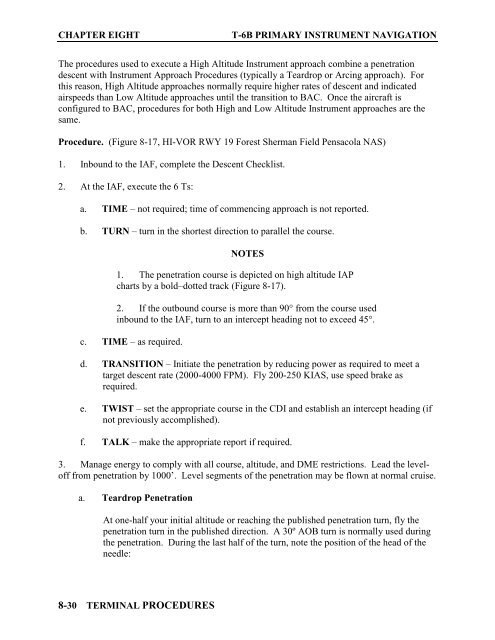Flight Training Instruction - Cnatra - U.S. Navy
Flight Training Instruction - Cnatra - U.S. Navy
Flight Training Instruction - Cnatra - U.S. Navy
Create successful ePaper yourself
Turn your PDF publications into a flip-book with our unique Google optimized e-Paper software.
CHAPTER EIGHT T-6B PRIMARY INSTRUMENT NAVIGATION<br />
The procedures used to execute a High Altitude Instrument approach combine a penetration<br />
descent with Instrument Approach Procedures (typically a Teardrop or Arcing approach). For<br />
this reason, High Altitude approaches normally require higher rates of descent and indicated<br />
airspeeds than Low Altitude approaches until the transition to BAC. Once the aircraft is<br />
configured to BAC, procedures for both High and Low Altitude Instrument approaches are the<br />
same.<br />
Procedure. (Figure 8-17, HI-VOR RWY 19 Forest Sherman Field Pensacola NAS)<br />
1. Inbound to the IAF, complete the Descent Checklist.<br />
2. At the IAF, execute the 6 Ts:<br />
a. TIME – not required; time of commencing approach is not reported.<br />
b. TURN – turn in the shortest direction to parallel the course.<br />
8-30 TERMINAL PROCEDURES<br />
NOTES<br />
1. The penetration course is depicted on high altitude IAP<br />
charts by a bold–dotted track (Figure 8-17).<br />
2. If the outbound course is more than 90° from the course used<br />
inbound to the IAF, turn to an intercept heading not to exceed 45°.<br />
c. TIME – as required.<br />
d. TRANSITION – Initiate the penetration by reducing power as required to meet a<br />
target descent rate (2000-4000 FPM). Fly 200-250 KIAS, use speed brake as<br />
required.<br />
e. TWIST – set the appropriate course in the CDI and establish an intercept heading (if<br />
not previously accomplished).<br />
f. TALK – make the appropriate report if required.<br />
3. Manage energy to comply with all course, altitude, and DME restrictions. Lead the leveloff<br />
from penetration by 1000’. Level segments of the penetration may be flown at normal cruise.<br />
a. Teardrop Penetration<br />
At one-half your initial altitude or reaching the published penetration turn, fly the<br />
penetration turn in the published direction. A 30º AOB turn is normally used during<br />
the penetration. During the last half of the turn, note the position of the head of the<br />
needle:
















